February 3, 2020 | By Margo Hammond
on Display Through March 6
Artist Talk — February 10 at 7 pm
Eckerd College
Details here

“We do a million things and never get an award,” says Suzanne Benton, referring to the unsung women of history. “That’s why this means so much to me.”
Benton is clutching a trophy to her chest. It’s a miniature Statue of Liberty. Benton and Amy Weintraub, a longtime advocate of reproductive rights, both were given one — the Gardner Beckett Liberties Award — by the Pinellas Chapter of the ACLU for their roles in launching and organizing the largest protest demonstration the county has ever seen.
The Women’s Solidarity March in St. Petersburg, held on January 21, 2017, drew 25,000 to downtown St. Petersburg. It was the day after the inauguration of Donald Trump. It was also Benton’s 81st birthday.
Benton cherishes the ACLU award so much that she carries it with her back and forth between her home in Ridgefield, Connecticut. where she summers, and her condo in St. Petersburg’s harborside Maximo Mooring where she winters. The condo — Benton calls it “a sacred space” since the march was planned in her living room — is a stone’s throw away from Eckerd College where for the past 14 years she has been a guest artist in the Visual Arts Department.

A metal sculptor, mask maker and performance artist, painter, lecturer, workshop leader and pioneer feminist activist, Benton, now 84, has had an impressive art career — 175 solo exhibitions, 150 group shows, two retrospectives of her work and visits to more than 30 countries with her art — with no sign of slowing down.

Sixteen of those solo shows and 37 of those group exhibitions have been held in her 70s and 80s, including the Asian Art Biennale in Dhaka, Bangladesh. Creating over 700 welded steel and bronze metal sculpture works and masks, Benton is represented in museums and private collections throughout the world.
She greets me at her condo as if we have known each other for a long time. I feel immediately at ease with this woman with her halo of curly hair and easy smile. Although her billowing coif is white not red, she reminds me of Merida, the most feminist — and fiercest — princess in the Disney canon. I look around and spot an easel and a piano, Benton’s two passions. Along the wall is a long table where she will show me examples of her latest monoprints and the exquisitely etched metal plates she uses in the process of making the one-of-a-kind prints. They are made with hand-made glued paper called chine colle which are pre-inked and hand-painted. The etched metal plates emboss a complex texture onto the prints.

I am meeting Benton for the first time to talk about her current show of monoprints at Cobb Gallery on the Eckerd campus. All of them were Made at Eckerd (the title of the show), 22 chosen from more than 400 she has created during her time at the college, including selections from two recent series, From Paintings in Proust and Circling Vermeer.
She will be talking about the show and her life of art and activism there on February 10 from 7-8:30 p.m.
She tells me that she is not interested in rattling off her accomplishments. “What I want to talk about at my lecture at Eckerd is this — what brought me to this place in my life?”
For years the Brooklyn-born Benton had little time for her art. Yet she persisted. She was married, raising children. Then she was divorced. After years as a painter, she began making steel- and bronze-welded sculptures when her youngest was two. She thought the choice understandable. “With all that heat (a welding torch flame is 3100°C) and pounding, I was releasing the anger and frustration I felt.”
Only recently has she realized that she also needed to release another emotion — grief. One of her three children, a daughter named Lisa, was born with a rare genetic disorder that progressively destroyed nerve cells in her brain and spinal cord. She went blind, couldn’t sit up and never spoke. She died at three. For a long time Benton couldn’t talk about Lisa’s death. “I’m just beginning to be able to say those words,” she says.

Art, which can be cathartic for the artists who makes it and for those of us who view it, has helped her heal.
My conversation with Benton is free-wheeling and exhilarating, jumping from art to politics to family. She talks to me about her mother whom she once called harsh and unloving, but whom now she thinks of more kindly. “As we grow older, we have no more need for villains,” she points out. “My mother was a feminist in her own way,” she remembers. “She certainly didn’t coddle her daughter.” Her mother pushed her to graduate from Queens College at 20 with a B.A. in Fine Arts when she herself hadn’t even finished high school.
She talks to me about her second daughter Janet, born the day after Lisa died. “She’s my best friend,” she says simply. She hands me an oversized postcard, a publicity flyer for her daughter’s novel — Lilli de Jong by Janet Benton. “You need to read it,” she tells me. It is the story of a mother. In 1883 Lilli de Jong, an unwed Quaker mother, is told she must give up her baby. Instead she chooses to keep her. “So little is permissible for a woman,” Lilli writes in her diary, “yet on her back every human climbs to adulthood.”
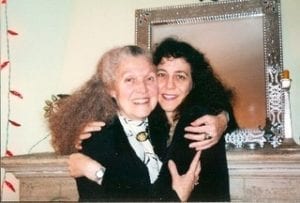
In 1996 the Veteran Feminists of America (an organization Benton helped found) was set to honor Benton and other activists on the 30th anniversary of the founding of the National Organization of Women (NOW). Benton, however, was busy leading a series of mask and story workshops with refugees in Bosnia and couldn’t make it to the awards ceremony. So her daughter Janet went instead.
An excerpt from Janet’s acceptance speech on behalf of her mother, posted on the VFA website, gives us the flavor of their strong mother-daughter bond:
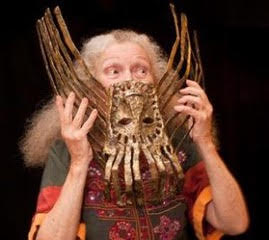
It wasn’t always easy having a mother dedicated to feminism and to becoming herself. I came home from third grade to find that my full-size baby carriage and baby doll who wet her pants, along with Barbie, her lovely accessories, and most of my stuffed animals, had been donated to a day-care center. While I got an appendectomy a few months earlier, Mom was marching through New York City streets with a procession of women wearing her metal masks, proclaiming the second coming of the great goddess. And after my parents divorced, I often came home to an empty house. It was a strange irony, the way that a joyous liberation and a freeing divorce sucked the joy from my life.

But I also received a treasure, one that I have come to understand as rare since hearing many people tell me what happened to the dreams, to the capacities of their mothers, and that is that my mother is a creative, strong, courageous woman who will never give up. The pride she has brought me, and the self-respect and assertiveness she has worked so hard to teach me, have proved more nutritive than hundreds of perfectly cooked meals.
So thank you for acknowledging Suzanne’s thirty years of work on behalf of women. It means a lot to both of us.
When I ask her if she ever gets discouraged by the setbacks in women’s rights, she retrieves a white wrinkled mask with crude holes cut in the place of her eyes and mouth and presses it to her face. “Are you afraid now that you know it can be taken? Stolen?” she says in a deep voice that echoes the female archetypes from mythology she channels in her performance art.
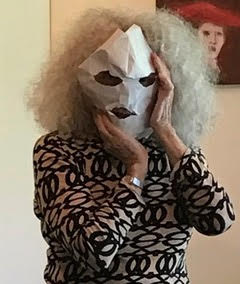
“I promise you, you are not alone. I tell you, there are others. I believe in we the people. I tell you, if you stand up, you will find powers you never knew you had. I have come to give you courage, to take away your despair. Find your cause. It’s waiting for you.”
Women and women’s right’s have been Benton’s causes in her life and in her work so it’s not surprising so many creative women have crossed her path from the surrealist painter Leanora Carrington, who was a founding member of the Women’s Liberation Movement in Mexico (Benton met her in New York) to feminist icon Doris Lessing to sculptor Janet Echelman.
Benton met Lessing at the 1989 International Association for the Fantastic in the Arts in Fort Lauderdale, an annual conference devoted to the fantastic in literature, film and other arts. Lessing was the main speaker — Benton had been invited to perform with her masks.
When she went up to meet Lessing, she was so tongue-tied at the thought of talking to the giant of feminist literature that she couldn’t remember a single title Lessing had written (though she had read them all).
Echelman, the Tampa-born artist commissioned to create one of her famous billowing net sculptures for the St. Petersburg Pier, sought out Benton. Echelman was applying for a Fulbright scholarship and wanted to talk to Benton about her experience with the prestigious scholarship — in 1992-93 Benton, on a Fulbright lectureship, had brought her masks to Jadavpur University in Calcutta, India.
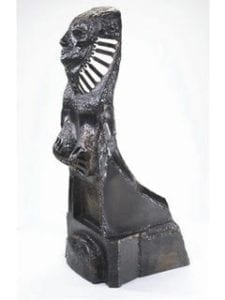
In the course of the conversation, Echelman suggested that if she got the Fulbright, Benton should take her place as artist-in-residence at Harvard. “Of course, Janet got the Fulbright and I ended up going to Harvard,” she laughs. In 2008 Benton donated her papers to Harvard/Radcliffe’s Schlesinger Library Archive.
Sometimes Benton talks about women she has met only on a canvas. She shows me her painting of Alice Paul, a longtime resident of Ridgefield who was a Suffragist, the main leader and strategist in the campaign for the 19th amendment that gave women the right to vote, ratified 100 years ago this year. While researching Paul’s biography for the painting, Benton discovered that she has a family connection to the women’s rights activist.
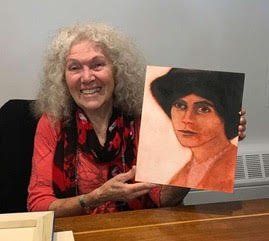
“My father’s sister was a Suffragist,” she says. “Throughout my childhood, my father would proudly tell me that his sister had had an ‘audience’ with president Woodrow Wilson to convince him to support the Women Suffrage Amendment.”
When Benton found out that Paul had formed a contingent of women to talk with the president about suffrage, she realized “that’s when my Aunt Regina Elkins Fruchter (who died in 1929 before I was born) had met face to face with Wilson.”

Benton’s painting of Paul is part of a year-long Portrait Project that Benton launched in Ridgefield to celebrate the Women’s Suffrage Centennial. She had originally kickstarted a similar endeavor here with a group of women artists, members of the St. Petersburg Branch of the Florida National Women’s Caucus that she founded last year.
The two projects, however, have slightly different focuses. In St. Petersburg the paintings are equal-sized portraits of 36 diverse working women who are known for fostering their communities.
Officials in Ridgefield, on the other hand, agreed to an interesting twist. Paul is the only famous woman who will be included in their Portrait Project. All the others will be portraits of the working women who toil behind the scenes in Ridgefield’s Town Hall.
Those women who do a million things and never get an award.
Explore Suzanne Benton’s work here
Suzanne will be giving a workshop on Printmaking
Without a Press at the Morean Arts Center February 22-23 – details here
This story was originally printed in Margo Hammond’s Creative Late Bloomers blog. You can find more stories of creative success after age 50 here.
Suzanne Benton gives a talk about her work titled
Rise to the Occasion at CreativeMornings St Pete in 2018
You can watch a series of Suzanne Benton’s Mask performances
including A Woman in Paris, Demeter and Persephone, Job’s Wife and The Bengali Bride.




